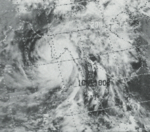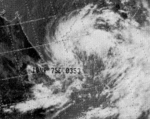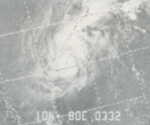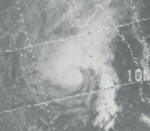| 1976 North Indian Ocean cyclone season |
|---|
 Season summary map |
| Seasonal boundaries |
|---|
| First system formed |
April 29, 1976 |
|---|
| Last system dissipated |
January 3, 1977 |
|---|
| Seasonal statistics |
|---|
| Total fatalities |
Unknown |
|---|
| Total damage |
Unknown |
|---|
| Related articles |
|---|
|
|
|
The 1976 North Indian Ocean cyclone season was part of the annual cycle of tropical cyclone formation. The season has no official bounds but cyclones tend to form between April and December. These dates conventionally delimit the period of each year when most tropical cyclones form in the northern Indian Ocean. There are two main seas in the North Indian Ocean—the Bay of Bengal to the east of the Indian subcontinent and the Arabian Sea to the west of India. The official Regional Specialized Meteorological Centre in this basin is the India Meteorological Department (IMD), while the Joint Typhoon Warning Center (JTWC) releases unofficial advisories. An average of five tropical cyclones form in the North Indian Ocean every season with peaks in May and November.[1] Cyclones occurring between the meridians 45°E and 100°E are included in the season by the IMD.[2]
Systems
Late April/Early May Bay of Bengal cyclone
|
Tropical storm (SSHWS) |
|
|
| Duration |
April 29 – May 2 |
|---|
| Peak intensity |
95 km/h (60 mph) (1-min) |
|---|
September Bay of Bengal cyclone
|
Tropical storm (SSHWS) |
|
|
| Duration |
September 9 – September 11 |
|---|
| Peak intensity |
95 km/h (60 mph) (1-min) |
|---|
This system killed 10 people and 40,000 cattle.[3]
Mid-October Arabian sea cyclone
|
Tropical storm (SSHWS) |
|
|
| Duration |
October 12 – October 19 |
|---|
| Peak intensity |
95 km/h (60 mph) (1-min) |
|---|
Mid-October Bay of Bengal cyclone
|
Tropical storm (SSHWS) |
|
|
| Duration |
October 14 – October 19 |
|---|
| Peak intensity |
85 km/h (50 mph) (1-min) |
|---|
Early-November Bay of Bengal cyclone
|
Tropical storm (SSHWS) |
|
|
| Duration |
November 1 – November 4 |
|---|
| Peak intensity |
85 km/h (50 mph) (1-min) |
|---|
Mid-November Bay of Bengal cyclone
|
Tropical storm (SSHWS) |
|
|
| Duration |
November 15 – November 17 |
|---|
| Peak intensity |
85 km/h (50 mph) (1-min) |
|---|
Late-December Bay of Bengal cyclone
|
Category 1 tropical cyclone (SSHWS) |
|
|
| Duration |
December 27 – January 3 |
|---|
| Peak intensity |
120 km/h (75 mph) (1-min) |
|---|







